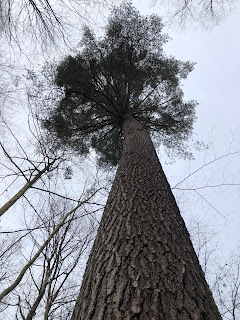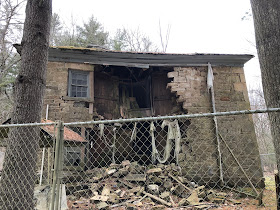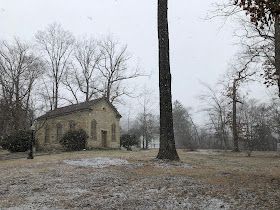I’d heard about the Anders Run Natural Area in the Cornplanter State Forest, but it always seemed too far-flung to bother with…until I came to own property up in that part of the woods. It’s a small 96-acre area of woodland in the hollow of Anders Run that hasn’t been logged since 1804. The pine and hemlock forests here are over 200 years old, and some publicity materials suggest that there trees here as old as 400-years.
I can’t tell the age of a tree just by looking, but there are indeed some massive specimens on the steep hillsides above the otherwise unremarkable Anders Run. Evergreen forests are such a luxurious thing, especially in winter.
I propped my cap and walking stick up against this old white pine just to give the photo a sense of scale.
Some trees in this area had blown down in recent years, and their gargantuan trunks are left to decompose on the forest floor. I had no interest in photographing fallen trees, but they were fearsomely majestic even in their destruction.
There are really only two miles of trails at Anders Run, with a small public gravel lane running through the middle—which spoils the ancient feeling of the forest here. But it’s a joy all the same to consort with these ages-old creatures who were alive and growing here since before the War of 1812…and maybe even before the First English Civil War…(1640s).
I accidentally strayed off into private lands and, as is my wont, I headed uphill in hopes of bagging an unclaimed peak on my peak-bagging page. I later learned that I’d reached the high eastern ridge of a certain Crippen Hill (1,883 ft.), but this is not its true summit, so I can’t claim it. Still, it was fun to explore.
Nice views off the Allegheny River. And by the way, the drive up here from my camp follows the river, and it is so, so beautiful—almost Alaskan in its wildness and strangeness and isolation.
These muddy roads crisscross the hillsides as soon as you leave the evergreen woods of Anders Run. I don’t know what kind of vehicles travel such roads.
On my way back down, the boundaries between public and private land appeared well enough marked.
Ah, but look at this lonely giant, so splendid in its power and its solitude. It contentedly passes its years in this one spot, and the world passes by unnoticed and unnoticing.
The nearest village is named Irvine in honor of the first landowners who had a large estate here. This is one of their early homes, built in 1841 and now fallen into ruin and fenced off. It sits in the woods in the valley of Anders Run. They apparently built larger houses in the village.
Historical preservation means so little in this state. Beautiful, historic buildings are forever falling into ruin and being left to rot, even on public lands where you would expect the state to take some responsibility for restoring them as a part of our cultural heritage. But no.
In the nearby village of Irvine, the eponymous founding family constructed the stone Presbyterian church in the exact same style as their home—maybe only slightly fancier, like “Greek Revival,” has nothing to do with the religious “revivals” of that era. I’ve never been inside, but I think I may have known the “lay pastor” who kept the flock here long ago. (I did her husband’s funeral, unless maybe I’m thinking of another really cool, historic Presbyterian church at Sugar Grove...The little village churches of that denomination are so old and beautiful up here, and I do judge them by their architecture.) The church was completed in 1838.
According to the website warrengives.com:
Dr. William Irvine built the stone structure as a wedding gift for his wife Sarah Duncan. Sarah was teaching Sunday School on their big porch for the children of their tenant farmers and local Indian children. She asked for a simple frame structure to use as a Church, but the Doctor had another vision. He hired an immigrant stonemason from Scotland to build the classic structure. Unfortunately, the first service in the Church was Sarah’s funeral, hence, the Church is known to the locals as the Church that Love built.













No comments:
Post a Comment